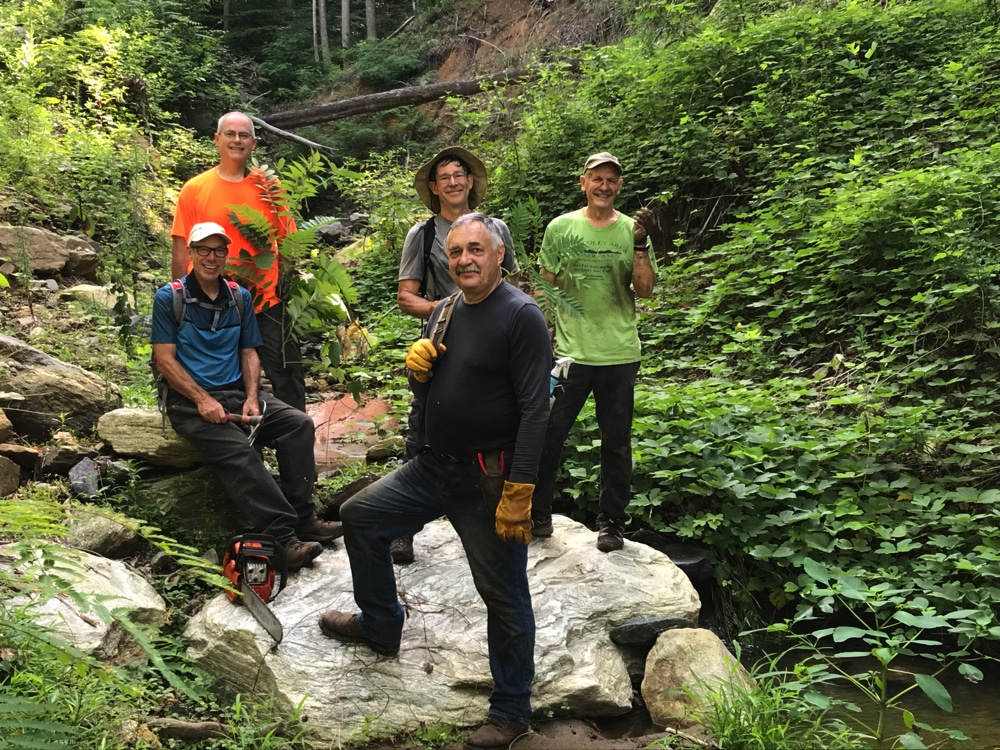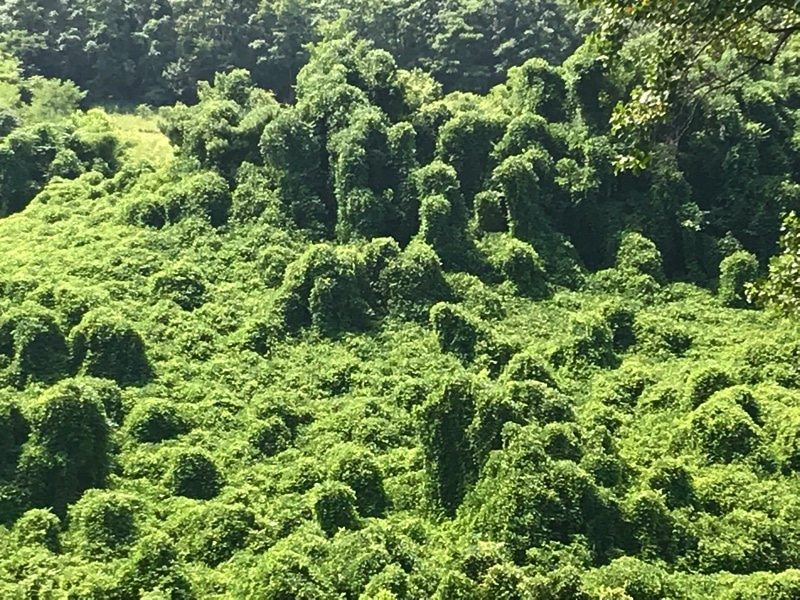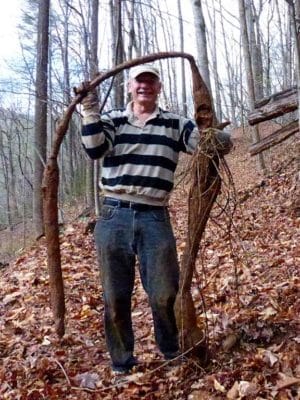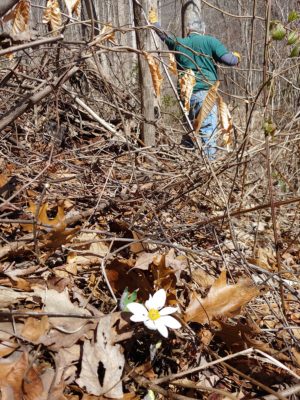The Kudzu Warriors

Volunteers keep kudzu from devouring a nature preserve.
Across the road from Norman Wilder Forest, it looks like another planet. A hillside is covered in bright green lumps, all blanketed in the same thick mat of leaves. Those lumps used to be trees. Now, they’re stubs propping up kudzu.
It would be hard to walk through thick kudzu, but if you did, you wouldn’t hear birds singing in the canopy. You wouldn’t hear owls hooting or see butterflies flit past. You probably wouldn’t come across any wildlife—well, maybe a groundhog.
That’s what Norman Wilder Forest was turning into when Greg Miner started volunteering there, nine years ago. Greg had started fighting kudzu on his own two-acre property in Tryon, where the vine was pulling down his trees. He started learning more about invasive plants, and in his research he met Pam Torlina, a stewardship manager with Conserving Carolina. Conserving Carolina owns Norman Wilder Forest, a 185-acre nature preserve between Saluda and Tryon, which is open to the public for hiking.
At the time, part of the preserve was solid kudzu. Pam recruited Greg to help fight invasive plants and they started a weekly volunteer crew, the Kudzu Warriors.

Are They Crazy?
Before he retired this year, Greg worked as a nurse. “My coworkers in the hospital would look at me like I was crazy,” he says. They’d tell him kudzu is an impossible problem—that it will always come back.
So why do these volunteers keep working so hard to get rid of it? At a coffee shop in Tryon after a work session in the blazing July heat, a group of Kudzu Warriors laughs and says you shouldn’t rule out insanity.
Seriously, they can name lots of reasons.
“It’s like any volunteer work,” Ted Altman says. “You actually get back more than you give.”

Don Dicey says it’s great for the camaraderie—sharing their stories every Monday morning as they work together and then go for coffee. Other members say it’s great exercise. It’s free training, so you know how to handle invasive plants on your own property. And it’s amazing to see the wildflowers that come back once the kudzu is gone: trilliums, bloodroot, mayapples, columbine.
“The silverbells are what got me,” says Ford Smith.
As these plants come back, you start to see more wildlife. Don says, “I run into turtles, I run into snakes, I run into salamanders.”
Greg says, “The biggest thing I get out of it is the enjoyment of seeing native plants regenerate after removing the invasive plants.”
From his point of view, their work is a step toward a paradigm shift—from a culture devoted to human profits to one that values the whole community of life.
Devastated by Mudslides
Last May, when Greg went out to Wilder Forest, it wasn’t your typical kudzu Monday. Large swaths of the forest were gone, gouged out by mudslides. After weeks of intense rain, the soil had lost its grip on bedrock. Flowing mud swept away mature forests. Boulders, trees, and mud poured over Highway 176, knocked a house off its foundation, and killed the woman who lived there.
It was after the mudslide that Ted got involved. “I didn’t start doing this because I hated kudzu,” he says. “I started doing it because I love Norman Wilder.” He lives just a mile from the forest and hikes the trails frequently. “After the big mudslide last year, I thought I ought to find out what I can do to help.”

The mudslides opened chasms across the hiking trails, so, for safety, Conserving Carolina had to close the forest. In the year since, volunteer groups helped to fix the trails, including Carolina Mountain Club, AmeriCorps Summer of Service and college groups on alternative spring break. This summer, thanks to their hard work, Norman Wilder Forest reopened.
The mudslides also made more work for the Kudzu Warriors, by turning shady tracts of forest into bare slopes open to the sun – the kind of opening that invasive plants pounce on. The Kudzu Warriors, along with AmeriCorps Project Conserve member Max Howes, have been hard at work keeping invasives like kudzu, tree of heaven, and princess tree at bay.
One morning in July, the Kudzu Warriors worked near the path of the mudslide, below a waterfall, where kudzu vines were colonizing the ground. They followed the vines to where they came out of the soil and dug out the crowns—a bulbous part of the taproot. If you fully remove the crown, you kill the plant. If it looked like part of the crown might still be underground, the volunteers sprayed that spot with a selective herbicide.

There’s a lot to show for their dedication. “I like looking to the other side of the river and comparing that to Wilder,” Max says. “I know Wilder once looked like that, in parts, and now it doesn’t.”
Most of Norman Wilder Forest is now free of kudzu. Areas that were once overrun with invasive plants are now beautiful places to enjoy wildflowers. In memory of his wife, Mara, Ford planted a grove of Restoration Chestnuts—a blight-resistant variety of American Chestnut—on ground that was once covered in kudzu. As trees grow and shade fills in, kudzu becomes less of a threat.
Once you’ve gotten to this point, the Kudzu Warriors say, your job is more manageable. Whether you’re controlling invasives on a nature preserve or on your own land, you need to just keep walking the land and catching any outbreaks early.
A Canyon of Kudzu
Still, it’s a daunting task. As you drive down Highway 176, it looks like a canyon of kudzu. Vines are devouring slopes and dangling from trees in a perpetual growth spurt. How do you take on a problem of that scale?
Don says if people are capable of wiping out dread diseases like smallpox, then we can manage kudzu.
At the coffeeshop, the Kudzu Warriors talk about experimental approaches: did you see the YouTube video about the teenager who discovered that pumping helium into the ground will kill kudzu? (Not that there’s enough helium available to eradicate the “vine that ate the South.”) They think trainings should be offered for landscapers on how to manage kudzu and other invasives—beyond just spraying chemicals, which can hurt the environment and might not kill the plants. They say the government should provide more leadership and grant funding. They look to land trusts like Conserving Carolina to manage invasives on conservation lands. They also say it falls to landowners like themselves to care for their own property.
A vital first step is to appreciate the life that make these forests special. The wood thrushes with their fluting songs. The roaming families of black bears. The white-flowering silverbell trees.
Ted says, “People need to know what they’re giving up by letting the kudzu take over. They need to know what it could be.”
VOLUNTEER WITH THE KUDZU WARRIORS
This article is written by Rose Jenkins Lane as part of our our monthly Stories of the Land series which runs in the Hendersonville Times-News. These stories explore people’s connection to the land and the ways they give back to the places they love.